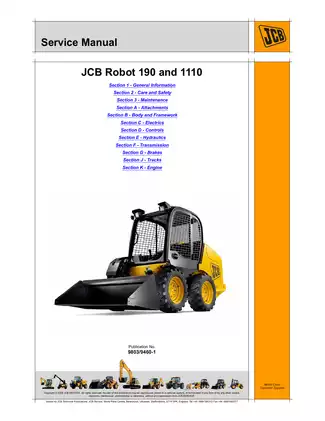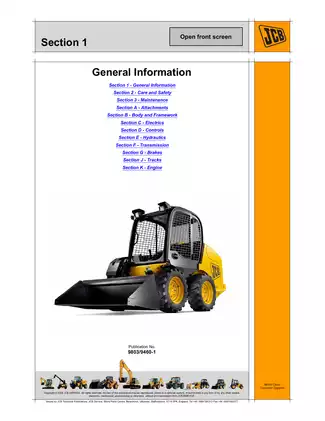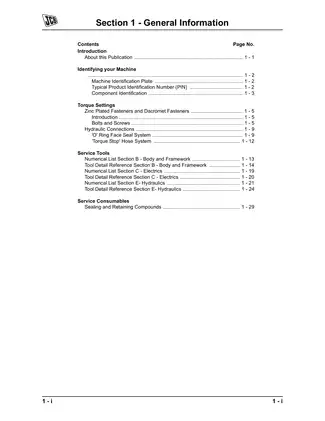2004 JCB Robot 190 and 1110 - Official Maintenance & Repair Reference for Skid Steer Loaders
Product Gallery

Sample pages from the 2004 JCB Robot 190 and 1110 - Official Maintenance & Repair Reference for Skid Steer Loaders manual



Purchase Information
JCB Robot 190 and 1110 Service Manual - Technical Specifications
- Document Number / Seller:
- 27798 / Daniel Stewart
- File Size:
- 14.55 MB
- File Type:
- Language:
- English
- Pages:
- 372
- Printable:
- Yes
- Estimated Download Time:
- 0.3 Minutes
- Delivery Format:
- Digital (PDF) - Instant Access
- Category:
- Skid Steer Loader
- Brand:
- JCB
- Reviewed and Approved:
- Jun 26, 2025
JCB Models and Parts Covered in this Skid Steer Loader Manual
- JCB Robot 190 (2004)
- JCB Robot 1110 (2004)
Complete Manual Information
JCB Robot 190 and 1110 Service Manual: Your Essential Maintenance Companion
Keep your JCB Robot 190 and 1110 running at peak performance with this thorough service manual. Designed for JCB Distributor Service Engineers and workshop technicians, this manual offers comprehensive insights into the operation, maintenance, and repair of your machine.
Key Features
- General Information: Understand the operational basics and specifications of your JCB Robot.
- Safety Guidelines: Prioritize safety with detailed warnings and necessary precautions during maintenance.
- Detailed Procedures: Step-by-step instructions for the removal, replacement, and maintenance of critical components like loader arms and hydraulic systems.
- Wiring Diagrams: Special diagrams for clear visualization of electrical connections and troubleshooting tips.
- Service Tools: A thorough listing of special tools recommended for maintenance-related tasks.
What's Inside?
- Section 1: General Information
- Section 2: Care and Safety
- Section 3: Maintenance Protocols
- Attachments: Maintenance specifics for implements
- Body & Framework: Complete details on body structure and removable components
- Electrics: Full wiring diagrams and electrical troubleshooting
This manual stands as an authority on the routine servicing and emergency repairs that keep the JCB Robot efficiently operational. Failures can be avoided with a well-informed maintenance plan established from the insights contained in this manual
Download Instructions for JCB Skid Steer Loader Manual
Frequently Asked Questions - JCB Skid Steer Loader Manual
What does this JCB manual cover?
This comprehensive service manual covers detailed repair procedures, maintenance schedules, troubleshooting guides, and technical specifications for 2004 JCB Robot 190 and 1110 - Official Maintenance & Repair Reference for Skid Steer Loaders. It includes information for the following models: - JCB Robot 190 (2004) - JCB Robot 1110 (2004).
Is this manual suitable for beginners?
Yes, this JCB manual is designed for both professional technicians and DIY enthusiasts. It includes step-by-step procedures with clear illustrations and safety guidelines for Skid Steer Loader maintenance and repair.
What file format will I receive?
You will receive this manual as a PDF file (14.55 MB), which is compatible with all devices. The manual is fully searchable and printable for your convenience.
How quickly can I access the manual after purchase?
You'll receive instant access to your JCB Skid Steer Loader manual immediately after payment completion. The download link is valid for 3 days, with lifetime re-download guarantee.
Can I print specific sections of the manual?
Absolutely! This digital manual allows you to print any section you need, from individual pages to complete chapters, making it perfect for workshop use.
Customer Reviews and Feedback
Read what our customers say about this JCB Skid Steer Loader manual and share your own experience.
Add Comment
This policy contains information about your privacy. By posting, you are declaring that you understand this policy:
- Your name, rating, website address, town, country, state and comment will be publicly displayed if entered.
- Aside from the data entered into these form fields, other stored data about your comment will include:
- Your IP address (not displayed)
- The time/date of your submission (displayed)
- Your email address will not be shared. It is collected for only two reasons:
- Administrative purposes, should a need to contact you arise.
- To inform you of new comments, should you subscribe to receive notifications.
- A cookie may be set on your computer. This is used to remember your inputs. It will expire by itself.
This policy is subject to change at any time and without notice.
These terms and conditions contain rules about posting comments. By submitting a comment, you are declaring that you agree with these rules:
- Although the administrator will attempt to moderate comments, it is impossible for every comment to have been moderated at any given time.
- You acknowledge that all comments express the views and opinions of the original author and not those of the administrator.
- You agree not to post any material which is knowingly false, obscene, hateful, threatening, harassing or invasive of a person's privacy.
- The administrator has the right to edit, move or remove any comment for any reason and without notice.
Failure to comply with these rules may result in being banned from submitting further comments.
These terms and conditions are subject to change at any time and without notice.
Comments (3)